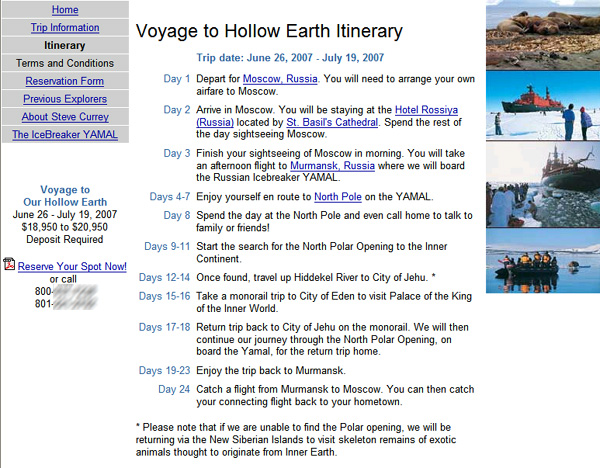|
Rotten Library > The Occult > Hollow Earth
Hollow Earth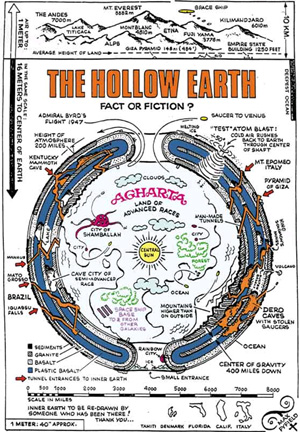 Once everyone finally agreed that the earth was round, the next natural step was to argue about what was inside. About 200 years after Columbus failed to prove the world was round by failing to sail all the way around it, and 170 years after Magellan got it right, Sir Edmund Halley put forward the first well-developed theory of the Hollow Earth.
Once everyone finally agreed that the earth was round, the next natural step was to argue about what was inside. About 200 years after Columbus failed to prove the world was round by failing to sail all the way around it, and 170 years after Magellan got it right, Sir Edmund Halley put forward the first well-developed theory of the Hollow Earth.
Halley, known the world over as "that comet guy", had been troubled by his study of the earth's magnetic fields, detected by compasses, and spent a fair amount of his life trying to come up with an explanation for why those fields were shifting. Eventually, he concluded that there had to be some sort of mechanism within the earth to explain the phenomenon. Halley wasn't the first person to speculate about vast underground spaces. The mad Jesuit Athanasius Kircher had already proposed vast networks of underground conduits and caves in his Mundus Subterraneus -- a collection of the geological knowledge of his day, compiled a couple of years before Halley's tract. But Halley took the cave concept a step further and thrust the Hollow Earth into a popular belief. He argued that the earth on which we live was simply a shell, inside of which floated another entire planet. Halley theorized that the outer shell was coated with a tarry substance that would ooze like caulk into any cracks formed by earthquakes or other unfortunate geological incidents, thus preventing the oceans from emptying into the hollowed-out earth like water running down a drain. He also argued that this theory explained a popular but mistaken view that the Earth had four magnetic poles -- two fixed and two floating. The fixed ones were on the outer shell and the floating ones were inside.
Halley's theory was almost entirely speculative, and the parts that weren't were based on egregious misconceptions about the actual facts of the world (from the Northern lights to the magnetic poles and beyond). Nevertheless, Halley's brand was sufficiently prestigious to keep the Hollow Earth theory alive for a long, long time -- far beyond the point that every sane person should have known better. The idea clunked around intellectual circles for the next couple centuries, but never reached any special level of credibility. However, ideas can be popular without being credible, and they can be enduring without being popular.
Yet Symmes was a man of conviction (however sane those convictions might be). The hollow earths had openings at the poles, Symmes claimed, and he proposed a polar expedition to prove his theory correct -- and presumably to explore and annex the Hollow Earth in the name of his homeland, the good ol' U.S. of A. The Senate actually seriously considered this plan, and the Russians offered to help underwrite it after the Americans declined, but the stars never aligned. Symmes' ideas, though dismissed by most rational scientists, nevertheless captured the popular imagination and became the subject of numerous additional crackpot theories and not a few science-fiction novels, including works by Edgar Allen Poe and Jules Verne.
After Symmes' death, an expedition finally was mounted, partly with the motive of finally putting all this Hollow Earth nonsense to rest. But even the footsteps of hundreds of people tromping around the ice floes of the north and the landmass of the south were not proof enough for those who wanted so desperately to believe. Figures like William Reed, Marshall Gardner -- and who could forget Cyrus Reed Teed -- elaborated increasingly whimsical theories about giants, dwarves, electric sun-gods, Eden and whatever else one might hope to find beneath the surface of the earth. However, the polar expeditions had largely crushed the Hollow Earth crowd's momentum... until one of those implausible things re-ignited the lunacy. Ray Palmer, editor of Amazing Stories, presented the tale of one Richard Shaver, who claimed to have journeyed to the interior of the earth and encountered all manner of strangeness within. Palmer published a series of accounts of the Hollow Earth which -- despite being published in a science fiction magazine -- were seized on by the usual lunatics. Among them -- the Nazis, some of whom believed in an underground world called Hyperborea from whence Aryan-loving gods could emanate at any moment to seize the world in the name of Adolf Hitler. As the facts piled up -- expedition after expedition -- against the Hollow Earth, an equal number of maniacs and shysters emerged to claim they'd made the trip. Finally, the unlikliest of sources provided a massive boost to the conspiracy-minded -- satellite imagery. An early satellite image of the north polar region seemed to show a gigantic black hole right where the theories predicted.
Simple explanations will not do for some people, who saw the picture as evidence of the biggest cover-up since the week before, at least. Subsequent photos of the poles? Cover-up. Pictures of expeditioners planting flags in Antarctica? Cover-up. Environmentalist whining about endangered polar species? Cover-up. March of the Penguins? Perhaps the most insidious cover-up of all... With so many options available to the discriminating consumer of paranoia today, one would think that the Hollow Earth would be, well, dead and buried by now. The classics never tarnish, but most Hollow Earthers these days require additional stimulation to get their juices flowing. For instance, the prevailing, um, "wisdom" holds that the inside of the Earth is now used as a launch pad for flying saucers. You can still find plenty of romantics who believe the Great Indoors contains the Garden of Eden, some iteration of Hyperborea, or Shambala, the Tibetan Buddhist mystical city best known for the profound infatuation it exercises on non-Buddhists who probably wouldn't enjoy a Buddhist paradise that much if they actually thought about it for a few minutes. Die-hards can actually sign up for new expeditions leaving for the North Pole on a regular basis to scrounge around in hopes of finding the secret door to the Twilight Zone. With beds starting around $19,000 and an itinerary that includes a "monorail trip to City of Eden to visit the Palace of the King of the Inner World", it's hard to imagine a better vacation value. As always, keep an eye on the fine print.
|
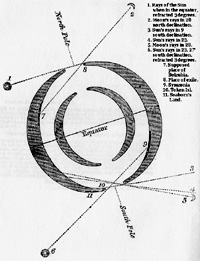 Running through a chain of increasingly shaky logic, Halley theorized that the inside earth was certainly inhabited by life and illuminated by some unspecified mechanism having to do with glowing clouds of air that occasionally escaped the inner shell to light up the night sky as the aurora borealis. (His theory didn't explain why the gas could get out, but the oceans couldn't drain in.)
Running through a chain of increasingly shaky logic, Halley theorized that the inside earth was certainly inhabited by life and illuminated by some unspecified mechanism having to do with glowing clouds of air that occasionally escaped the inner shell to light up the night sky as the aurora borealis. (His theory didn't explain why the gas could get out, but the oceans couldn't drain in.) 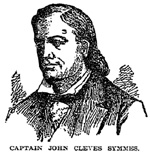 The Hollow Earth was ushered into the 19th century by a man named John Symmes, who proposed that not only was the earth hollow with another earth inside it, but that the inside earth was also hollow. Variations of theory stipulated two, four and seven shells within. Symmes' theories would have looked more credible if he'd simply published them under his own name, but he transparently attempted to puff himself up by writing treatises about the brilliance of his own theories under assumed names, including one that modestly dubbed the fabulous land of mystery within "Symzonia".
The Hollow Earth was ushered into the 19th century by a man named John Symmes, who proposed that not only was the earth hollow with another earth inside it, but that the inside earth was also hollow. Variations of theory stipulated two, four and seven shells within. Symmes' theories would have looked more credible if he'd simply published them under his own name, but he transparently attempted to puff himself up by writing treatises about the brilliance of his own theories under assumed names, including one that modestly dubbed the fabulous land of mystery within "Symzonia".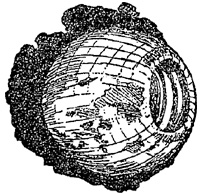 Depending on who you talked to, the interior earth was illuminated by the sun through the ocean floor, by phosphoric fungi, or by an adorable miniature sun inside the innermost earth, however many you thought there might be.
Depending on who you talked to, the interior earth was illuminated by the sun through the ocean floor, by phosphoric fungi, or by an adorable miniature sun inside the innermost earth, however many you thought there might be. 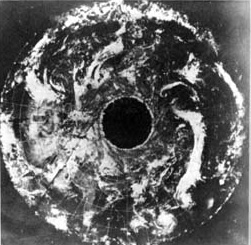 The image was produced by an orbiting satellite as a photo-mosaic. Each section of the photo was a single picture taken at a certain point in the orbit, then the individual pictures were assembled like a puzzle. Because of the angle of the orbit, the actual pole was not photographed, and the scientists assembling the montage simply left the area blank.
The image was produced by an orbiting satellite as a photo-mosaic. Each section of the photo was a single picture taken at a certain point in the orbit, then the individual pictures were assembled like a puzzle. Because of the angle of the orbit, the actual pole was not photographed, and the scientists assembling the montage simply left the area blank. 